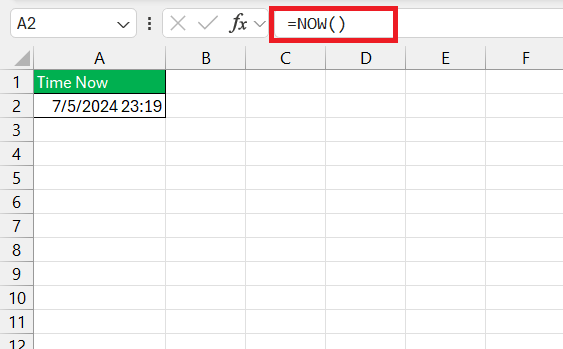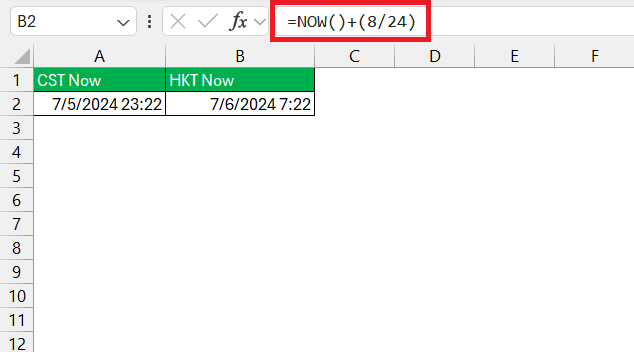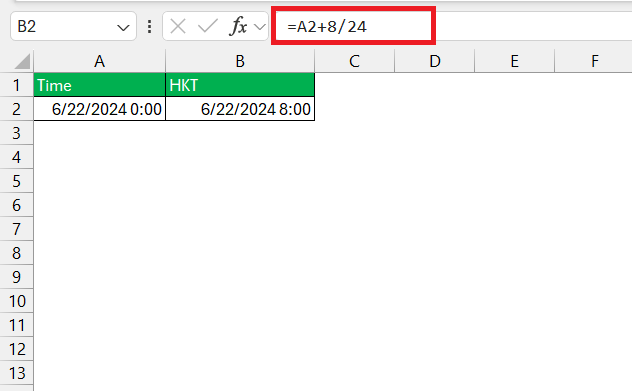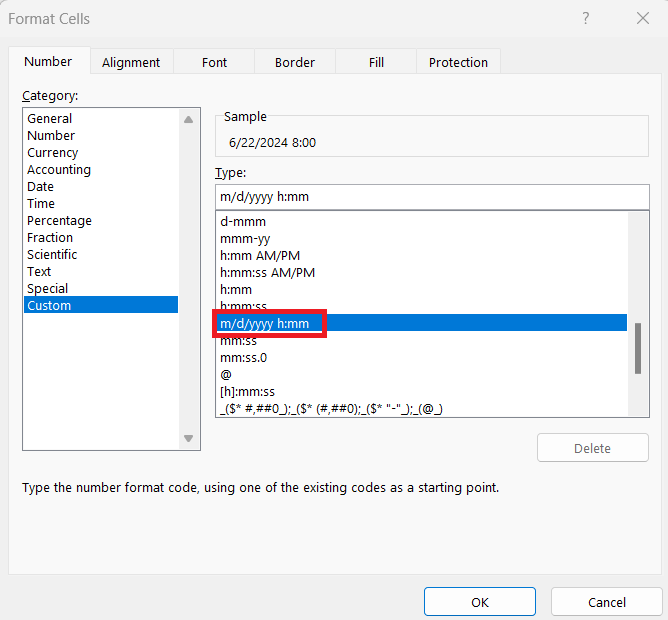Understanding time zones is crucial in a globalized world, where scheduling and communication across different regions can be challenging. Converting time accurately between zones is essential for both personal and professional activities. For those connected to Hong Kong, staying in sync with Hong Kong Time (HKT) is vital, as it ensures effective communication and timely coordination with partners, clients, and colleagues in this major financial hub. In this article, we will cover a detailed guide on how to show Hong Kong time now in Microsoft Excel.
Key Takeaways:
- Typing =NOW() into a cell displays the current date and time dynamically, providing real-time updates useful for timestamping and time-sensitive reports.
- Adjust times accurately in spreadsheets by adding or subtracting the time difference (e.g., adding 8 hours for HKT).
- Show Hong Kong time now with =NOW() + (8/24).
- Ensure Excel’s automatic recalculation is on (Formulas > Calculation Options > Automatic) and correct cell formatting. Use F9 to manually recalculate if needed.
- Manually adjust formulas for DST changes. Hong Kong does not observe DST, simplifying its time zone conversions.
Table of Contents
Introduction to Time Zone Conversions in Excel
Why Time Zone Conversion Matters
Understanding time zones is crucial when dealing with international data exchanges. They can affect your scheduling, and deadlines, and can create confusion if not managed properly. In today’s globalised environment, the need to convert time accurately between different zones can’t be overstated, whether for personal or professional reasons.
The Relevance of Showing Hong Kong Time Now
When you or your business is connected to Hong Kong, it’s important to stay in sync with local time there. This bustling hub for finance and trade operates in the Hong Kong Time Zone (HKT), which is UTC/GMT +8 hours. Keeping track of HKT helps in effective communication and scheduling with partners, clients, or employees based in the region, and ensures you don’t miss critical deadlines or meetings due to time differences.
Key Functions for Time Zone Conversion
The NOW Function: Fetching Current Time
The NOW function in Excel is a straightforward yet powerful tool for displaying the current date and time in a spreadsheet. Simply typing =NOW() into a cell prompts Excel to fetch the system’s date and time.
It’s dynamic, updating automatically every time the worksheet recalculates, which can be particularly handy for timestamping or creating time-sensitive reports.
Custom Formulas to Account for Time Differences
To tailor time zone calculations to your needs, custom formulas come into play. By adding or subtracting the time difference, usually in hours, you can adjust the time to match another time zone. For instance, to convert IST to HKT, you’d add 8 hours to your formula. It’s a bit more complex when time zones aren’t a neat number of hours apart, or when converting a batch of times, but with Excel’s flexibility, custom formulas can do the heavy lifting.
Step-by-Step Guide to Convert Time to Hong Kong Time Zone
Example 1: Using NOW() Function for Hong Kong Time
To have the NOW function display Hong Kong time, you’ll tweak it to consider the time difference between UTC and HKT, which is 8 hours ahead. So, the formula becomes =NOW() + (8/24).
This takes the current UTC time provided by the NOW function and adds the 8-hour offset, converting it to Hong Kong time now. Make sure to format the cell to a date and time format that suits your preference.
Example 2: Convert a Specific Time to Hong Kong Time
To convert a given time to Hong Kong Time, you would use the same principle of adding the 8-hour time difference. If your provided time is in cell A2, the formula would be =A2 + (8/24).
This adjustment ensures that you have the time reflected in HKT.
Common Challenges and Solutions
Troubleshooting Time Function Errors
If the NOW function isn’t working as expected, don’t worry, they’ve got this covered. First, check that Excel’s automatic recalculation feature is on: this ensures that the NOW function updates with every change or refresh. Head over to “Formulas”, click on “Calculation Options”, and select “Automatic”.
Also, check the cell formatting—is it showing a weird serial number? Change it to a date and time format.
If the problem persists, hit F9 to nudge Excel to recalculate manually.
Dealing with Daylight Saving Time Adjustments
Daylight Saving Time (DST) can throw a wrench in your time zone conversions, as it requires adding or subtracting an extra hour during certain periods of the year. Unfortunately, Excel doesn’t automatically account for DST. They need to manually change their formulas to add or subtract that extra hour when DST starts or ends.
Bear in mind the dates that these changes take place, as they can vary depending on the country. For regions like Hong Kong that don’t observe DST, conversions are more straightforward, as you won’t need to adjust for these fluctuations.
Practical Applications of Time Zone Conversions
Business Implications of Accurate Time Tracking
For businesses operating across multiple time zones, pinpoint accuracy in time tracking isn’t just important—it’s essential. It affects project deadlines, working hours logging, global team meetings, and even customer service availability.
Efficient and precise tracking ensures seamless operations, prevents misunderstandings, and upholds the professionalism of a brand. Leveraging Excel’s time conversion capabilities can thus be a low-cost yet highly effective tool in any organization’s workflow.
Personal Use Cases: Managing Global Schedules
If you’re someone with friends, family, or work obligations around the world, converting time zones in Excel can transform how you manage personal commitments. You can create your own global schedule, ensuring you catch up with a friend overseas at a reasonable hour or log in to remote webinars just in time.
Excel can help you streamline your personal life, so time differences lead to fewer missed connections and more meaningful interactions.
FAQ Section
How to display the current time in Excel?
To display the current time in Excel, use the NOW function. Enter =NOW() into a cell, and it will show the current date and time. If you only want to display the time, you can use the shortcut Ctrl+Shift+; (semicolon), or format the cell to only show time after inputting the NOW function.
How do I format international time in Excel?
Formatting international time in Excel is a breeze. Right-click the cell with your time, select ‘Format Cells’, then under ‘Category’, choose ‘Time’. You’ll see a variety of international time formats. If they need a custom format, select ‘Custom’ and set it up in the format code box.
How do I automatically insert the current date and time for Hong Kong in Excel?
To automatically insert the current date and time for Hong Kong in Excel, type =NOW() + (8/24) in a cell, which adds 8 hours to the current UTC time provided by the NOW function. Remember to format your cell for the date and time.
Can Excel convert time zones using built-in features or do I need a custom solution?
Excel doesn’t have a built-in feature for time zone conversions reflecting daylight saving changes or varying time zones, so you’ll often need to use custom solutions. This typically involves adding or subtracting the time difference manually using formulas. However, for more complex scenarios, Power Query in Excel can handle time zone conversions with more advanced options.
How to do time zone conversion in Excel?
To do time zone conversion in Excel, determine the time difference between the zones. Then, use a formula like =YourCell + (TimeDifference/24) to convert to the target time zone. Use - instead of + if you’re converting to an earlier time zone. Ensure the cell to display the date and time appropriately.
John Michaloudis is a former accountant and finance analyst at General Electric, a Microsoft MVP since 2020, an Amazon #1 bestselling author of 4 Microsoft Excel books and teacher of Microsoft Excel & Office over at his flagship MyExcelOnline Academy Online Course.












